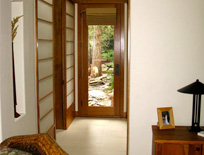A Doorway to Emotional Value

 The true test of whether a watershape is well-conceived and well-built is what happens in the minds of the clients when they view the finished product. Not only should they appreciate the beauty of the work, they should also feel a personal connection to it that generates even deeper levels of satisfaction and pleasure.
The true test of whether a watershape is well-conceived and well-built is what happens in the minds of the clients when they view the finished product. Not only should they appreciate the beauty of the work, they should also feel a personal connection to it that generates even deeper levels of satisfaction and pleasure.
The origin of this kind of appreciation lies in how clients describe their ideas and desires, starting with the initial meetings with the watershaper and continuing with the walk-throughs of the site. I’ve found that by truly listening to clients — their spoken words and, equally important, their facial expressions and body language — I can garner invaluable nuggets of information that help me create the best watershape for them.
Needless to say, the things I learn from these conversations can facilitate the proper placement of liners, rocks and pumps. More significant, when the external appearance of a waterfeature truly reflects the internal vision of the clients (as interpreted and expressed by the creative talent of the watershaper), something magical can result: a work of enduring and priceless emotional value.
The vision can take on any number of physical forms. It can be a piece of sculpture, for example, or an antique item where the story behind the object becomes a point of pride and a conversation starter. It can be the placement of a certain unusual stone the clients have selected, so that the stone serves as a key focal point. The way the sound of the moving water brings a feeling of tranquility. Or how the watershape interacts with a particular vista or establishes a destination in a space that otherwise might be ignored.
The specifics are as varied as the clients themselves. The trick for the watershaper is to identify threads of emotional connection and weave them together during both the design process and construction work, as well as in the end result. This is why I consider myself a detective of sorts, always on the lookout for one or more elements of a project that will forge these emotional threads and generate delight, pride and long-term satisfaction.
The installation pictured here is an example of how a vision can come to define a project in the clients’ minds. The clients in this instance had built an addition onto their home; in the process, a construction door was cut to the outside to minimize traffic and dust through the living area. This door opened into a small section of the yard that, secluded and removed from the rest of the space, was mostly overgrown and ignored.
When the clients and I walked through the property for the first time, they mentioned they had decided to leave the opening as a full glass door and were now imagining a natural Japanese garden on the other side. This single idea of opening out to an intimate garden jump-started our creative process and led to the unfolding of a series of key concepts.
The new focal points included a stone bridge, a beach section and a path that, with each turn, revealed another aspect of a pond that was fully hidden from the previous view. When these individual details and vignettes became parts of the overall picture, they expanded the vision that had started with the simple idea of a new door opening onto a new space. In effect, the vision began with the addition and grew by way of a supposedly temporary doorway.
From Concept to Magic
This is precisely the sort of conceptual process that can result in magic for clients. Now these clients can sit and contemplate what we all have created. They can see how their ideas and instincts have led to a new, beautiful physical reality. For them, it undoubtedly is a powerful experience.
The individuals in our industry who are caught up in moving massive stone pieces, digging trenches, laying down liners and placing pipes may find it difficult to recognize the emotional and psychological magic that can happen. Nonetheless, I would argue that this is, in fact, among the most practical aspects of what we do for a living. As I see it, without the emotional connections embodied in these projects there would be little point in building watershapes at all.
I am here to enable my clients to realize their visions and desires. From start to finish, this is an emotional process by its very nature. The process calls on me to be sensitive to, and enthusiastic about, the nuances of what my clients and I are exploring and defining.
Again, this is why it is so important to pay attention to the internal world that underlies our clients’ spoken words. When you can truly hear your clients in all the dimensions of communication and transform your understanding into the perfect physical expression, a deep, mutual relationship can form that is warmly appreciated by both sides.
Dave Garton, owner of Lawnchair Watershapes in Denver, is an expert pond and stream builder, as well as an in-demand business speaker and coach. He is a frequent contributor to WaterShapes. For more information, go to www.davegarton.com.









